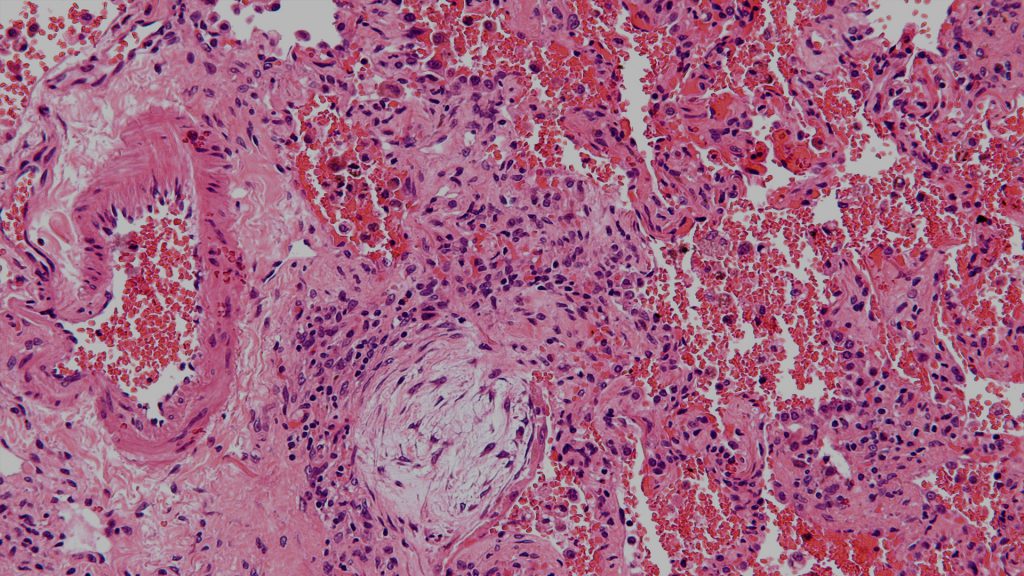Add-on tiotropium

Add-on tiotropium versus step-up inhaled corticosteroid plus long-acting beta-2‐agonist in real-world patients with asthma Allergy and Asthma Proceedings, 2020 A step-up approach (increasing inhaled corticosteroid [ICS] dose and/or add-on treatment) is recommended for asthma that is uncontrolled despite ICS plus long-acting beta-2‐agonist (LABA) combination treatment. Understanding the impact of different treatment options on health outcomes […]
Inhaled steroids reduce ACE2 expression lungs

As the COVID19 pandemic spreads across the world, its primary manifestation in severe or critical disease remains respiratory, beginning with pneumonitis, progressing through acute respiratory distress syndrome to terminal respiratory failure. At present, therefore, people who already have chronic lung disease, including asthma and chronic obstructive pulmonary disease (COPD), are at very high risk for […]
Asthma inhalers being trialed for treatment of COVID19

Researchers from Queensland University of Technology and Oxford University are working in collaboration to begin human clinical trials of inhaled corticosteroids, commonly used for asthma patients, on patients with COVID19. The researchers believe that this could be useful for patients with the novel coronavirus infection. The COVID19 pandemic The novel coronavirus or severe acute respiratory […]
Asthma inhalers may suppress children’s growth

Corticosteroid drugs that are given by inhalers to children with asthma may suppress their growth, evidence suggests. Two new systematic reviews published in The Cochrane Library focus on the effects of inhaled corticosteroid drugs (ICS) on growth rates. The authors found children’s growth slowed in the first year of treatment, although the effects were minimised […]
Asthma does not appear to increase the risk of COVID19

Asthma does not appear to increase the risk of COVID19 Older age and conditions such as heart disease, high blood pressure, chronic obstructive pulmonary disease, diabetes and obesity are reported risk factors for the development and progression of COVID19. Older age and conditions such as heart disease, high blood pressure, chronic obstructive pulmonary disease, diabetes […]
Asthma At A Glance

Asthma is a chronic inflammatory disease characterized by recurrent respiratory symptoms such as breathlessness, cough, and wheezing as well as chest tightness. In normal conditions, the air is free to move within our lungs through a complex conductive system also called airways. In specific conditions and when asthmatic patient conditions are uncontrolled, the airways are […]
Treatment of asthma

Budesonide/salmeterol in fixed-dose combination for the treatment of asthma Fixed-dose combinations (FDC) of inhaled corticosteroid (ICS) and long-acting beta-agonist (LABA) are well established in asthma treatment. The budesonide/salmeterol (B/S) FDC is now about to reach the market. It is provided as a powder in hard capsules of two strengths: 120/20μg and 240/20μg when expressed as […]
Treatment comparison of budesonide with salmeterol

Treatment comparison of budesonide/formoterol with salmeterol/fluticasone propionate in adults aged > or =16 years with asthma: post hoc analysis of a randomized, double-blind study Affiliations Three fixed maintenance-dose inhaled corticosteroid/long-acting beta(2)-agonist (ICS/LABA) combinations for the treatment of asthma are currently available: salmeterol/fluticasone propionate (Seretide/Advair/Adoair) budesonide/formoterol (Symbicort) and beclometasone/formoterol (Foster). All of these combinations have proven […]
Combining tiotropium and salmeterol

Combining tiotropium and salmeterol in COPD: Effects on airflow obstruction and symptoms Affiliations Clinical information on 24-h spirometric efficacy of combining tiotropium and salmeterol compared to single-agent therapy is lacking in patients with COPD. Methods: A randomized, double-blind, four-way crossover study of 6-week treatment periods comparing combination therapy of tiotropium 18 microg plus QD or […]
Diagnosis and management of iron deficiency in children

Diagnosis and management of iron deficiency in children with or without anemia: consensus recommendations of the SPOG Pediatric Hematology Working Group Iron deficiency is the most prevalent nutritional deficiency affecting children and adolescents worldwide. A consistent body of epidemiological data demonstrates an increased incidence of iron deficiency at three-time points: in the neonatal period, in […]

